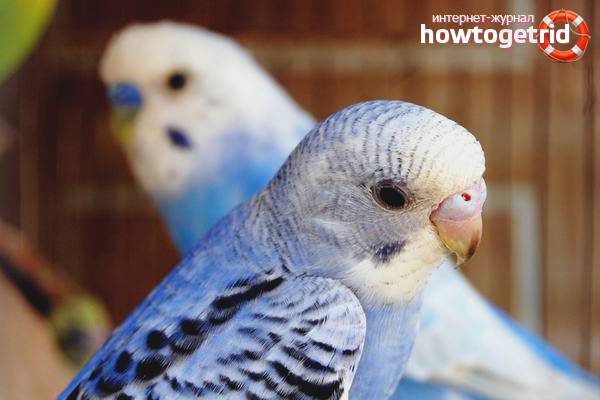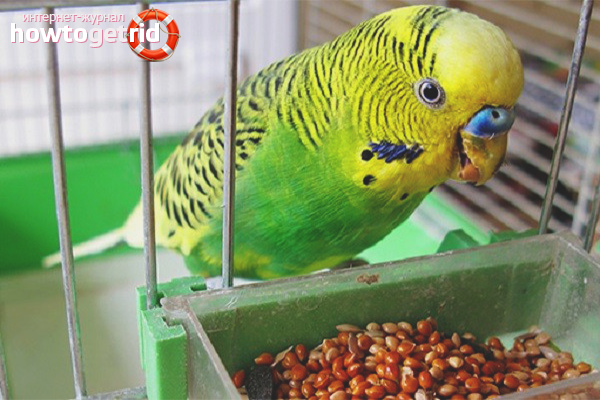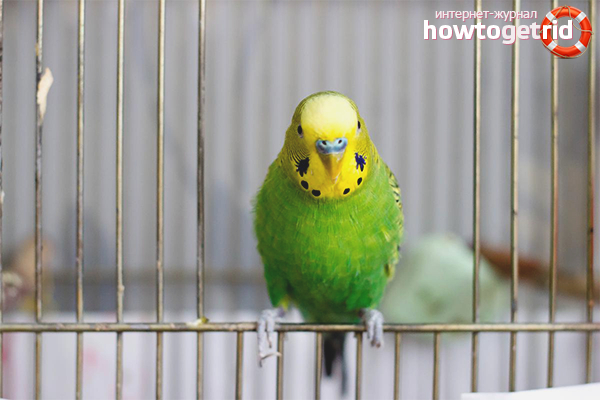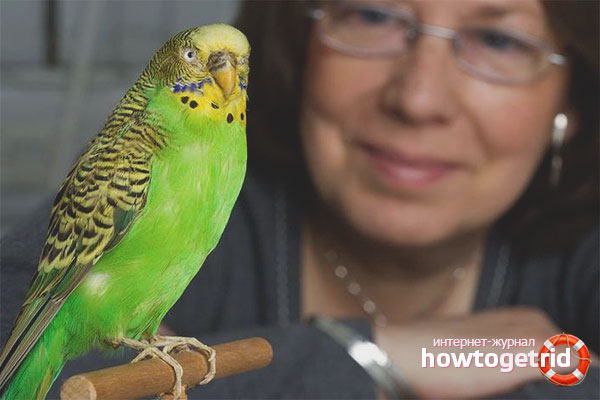The content of the article
Have you decided to make a feathered friend? It is worth carefully preparing for his arrival. Buy the necessary equipment, equipped cage and food at the pet store or bird market. Now you can safely go for a parrot. After moving the baby in a new home, make sure that the pet is quarantined for 10 days. If you are already the proud owner of feathered creatures, add a new comrade to them. Do not forget to come up with a parrot sonorous name, which he will get used to in two weeks.
General recommendations for keeping a parrot
- The animal’s house must be equipped with perches, a drinking bowl, a bathhouse and a feeding trough. The presence of river sand, fine wood and eggshells will not be superfluous, they are needed for proper digestion.
- Position the cage so that you have eye contact with the animal. Avoid places with drafts, feathered relatives often get sick. However, do not put the house next to a heater or heating radiator. The optimum temperature of the content ranges from 18 to 22 ° C. The parrot cage should be well lit, but not naturally, but artificially.
- Carry out daily cleaning, removing garbage from grains and bird droppings, wash the drinker and change the litter.
- Once a month do a general cleaning of the house. Moisten an ordinary rag in a solution of chamomile or hypericum flowers, then carefully wipe all contaminated areas.
- It is important to carry out sanitation every season. Moisten a kitchen sponge in a solution of water and soda (ratio - 1 liter per 100 g.), And then thoroughly treat the cage.
- Do not turn on the music at maximum volume in the room where the cage with the pet is located. At first, try to talk with the parrot quietly so as not to scare him. No need to climb into the house, let the pet get comfortable and get used to the new owners.
- Give your pet an opportunity to fly, after closing all the windows. Limit your parrot outings to the same room as it will be easier to maintain control. Blind the windows, birds tend to crash into glazed objects.
Feeding parrots
Basically, birds feed on grain feed, which is sold in absolutely every pet store. Other foods that your pet will eat are considered a treat. View clear parrot food. So in advance you will discover a possible mold and protect your pet from possible poisoning.
Daily diet supplement
Read the “Composition” column on the food package, then indulge the parrot with something that is not in his daily diet. It is allowed to feed the bird with sunflower seeds, as well as sprouted grains. The latter contain a lot of vitamin E, which has a beneficial effect on the feathers, claws and beak of the pet.
Parrots love spinach, clover, lettuce, dandelions and ordinary fresh grass. If you plan to feed the bird “street” food, collect plants away from the road and the construction site.
An excellent option for treats is an herbal dry mixture consisting of plants dried in the oven.
Regarding vegetables and fruits, birds do not really like them.
In order to pamper your pet, boil one egg and chop it finely, add a little grated carrots and crushed white crackers.
Drink
It is advisable for birds to pour natural water from bottles. There are no harmful impurities in such a drink, which positively affects the digestion of the parrot.
The drinker needs to be changed daily, each time pouring fresh water. You may well add a few drops of lemon juice, it is very useful.
Parrot diseases
Feathered friends have a number of common diseases that need to be considered in more detail.
Diarrhea
Symptoms of the disease are considered to be the following: a change in the consistency and color of the litter, the constant presence of the pet on the floor of the cage.
If you do not have the opportunity to visit a veterinarian, then rinse the baby in the anus, then drink infusion of chamomile flowers.
Poisoning
In 98% of cases, this disease is fatal. Do not smoke in the room where the parrot lives; exclude the use of air fresheners, deodorants, hair sprays and other similar products in this room. If the repair is brewing, take the house to another place where paint, whitewashing, etc. will not be applied.
There are frequent cases when parrots are poisoned with poor-quality food.
Parrot disease
The most dangerous disease of all that is transmitted to children with weakened immunity. Symptoms: eye inflammation and tearing, runny nose, diarrhea, excessively slow and labored breathing.
It is impossible to cure on your own, hurry to the veterinarian and limit the communication of children with the pet.
Cold
A frequent ailment in birds, parrots are no exception. Symptoms include difficulty and rare breathing, redness of the eyes, regular sneezing and runny nose.
As a treatment, use an infrared lamp, which can be purchased at a pet store (price about 300 rubles) or on the construction market (price 60 rubles). Direct heat so that it covers the entire cage.
Many poultry farmers use a conventional incandescent lamp instead of infrared.
If you become a caring parent, the child will not be sick at all. Take care of your pet, monitor your diet and avoid dangerous situations.
How to teach a parrot to a tray
To the surprise of many, parrots are also accustomed to the toilet. To this end, you need to agree with your family that from now on you will act together. Select a specific command and pronounce it with one intonation. Prefer a voiced phrase or a word that cannot be confused with another exclamation. Of course, you can say “Fly to the toilet!”, But it’s better to choose a more relevant technique.
The mentor for the pet should be one member of the family who will explain to the parrot what, where and how. When the baby decides to defecate, his behavior will be atypical, you need to remember these movements. Perhaps the bird will retreat or crouch, observe and draw a conclusion.
At the first sign of emptying, grab a parrot and hold it over the intended toilet, often saying the command. Now the main task is to create the necessary associations between the tray and the desire of the pet. Consider the fact that if you made a newspaper a newspaper or a plate, the parrot will spoil all such objects in the house.
You kept the parrot in the right place, and he safely did his job? Praise, give me a treat. Next time, take the pet in your hands again, hold until it is empty, again stroke and glue it. Repeat such simple manipulations as often as possible, then everything will turn out! Do not be discouraged and do not scold the parrot if the situation gets out of control. Remember, he is still small and does not really understand what the owner wants.
Parrot training
Parrots are relatively easy to train if their owner has perseverance and patience.
Do not make sudden movements when approaching the pet’s house, always call him by name, and not “My good!” or "hey you!"
Hand feeding
After two weeks of living in a new house, the bird will get used to you and you can teach it to eat food from your hand. Take your favorite treat and put it into the cage through the bars, repeat the maneuver until the parrot starts to take food from you.
After that, proceed to the second stage: stick your hand into the cage, showing the baby that it is time to go to your side. He must be courageous and sit on the brush. As practice shows, the training of dishes from the hand and the transition to it are quite easy. When the bird changes to you, slowly take it out of the house. Over time, a pet can be trained to fly to the call by name and land on an elongated limb.
Memorizing phrases
Feathered friends have excellent hearing, remember the timbre of the voice and try to repeat it. Parrots easily pronounce phrases in a cute chirping voice, imitate other animals and hum songs. Parrots are better positioned towards a female mentor than a male.
Training should be done at an early age (2-3 months). For this period, place the pet in the hotel room, and be for him the only one mentor. Every day, say 30-50 times the same phrase that the baby should repeat. If successful, do not skimp on goodies and praise.
You should always start by learning elementary short words that contain the letters O, A, I, P, P, K, T. After the pet has mastered them, move on to other vowels and consonants. Gradually increase the number of letters in the word, lengthen phrases or phrases. If the bird has learned the lesson, regularly communicate with her so that everything is preserved in her memory.
Keeping a parrot at home is not difficult if you approach the animal’s health wisely. Keep track of your pet's nutrition, change the water in a drinking bowl in a timely manner, and conduct seasonal and monthly sanitation. Learn interesting and funny phrases that you will listen to later with emotion. Parrots are one of the most moving creatures on the planet, but they are also defenseless against chemicals and open windows. Love and protect your pet! Perhaps he will even say, “Thank you!”
Video: caring for a budgie














Submit